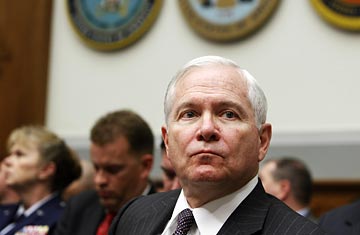
Robert Gates testifies on Capitol Hill
Defense Secretary Robert Gates may have helped right the Iraq war, and he took Afghanistan by the scruff when he fired the top U.S. commander there for poor leadership after only 11 months on the job — but those challenges pale before the struggle he faces in selling Capitol Hill on his plan to retool the U.S. military. Appearing before the House Armed Services Committee on May 13, Gates faced complaints that the changes envisaged in his latest defense-budget proposal pre-empt the the mammoth Quadrennial Defense Review (QDR) currently under way. The QDR, legislators argued, is an honest assessment of military needs by military professionals rather than a budget-driven exercise led by political appointees. But the QDR typically also reinforces a status quo that Gates insists does not reflect America's military needs for the 21st century.
"How do we now not have a QDR process that is imbued with the conclusions that you have already made?" asked Representative John McHugh of New York, the ranking Republican on the House Armed Services Committee. Gates dismissed the QDR as a relic designed to preserve an old way of war-fighting that is no longer relevant. "You are saying that I'm going to try and shape this QDR," the defense chief countered. "My answer is, You're darn right." (See pictures of a new high-tech aircraft being developed for the Air Force.)
Gates, in his testimony, sought to impose a rational sensibility on a military procurement process that has, enabled by lawmakers, run amok. He patiently swatted away suggestions that China's air force is primed to wipe U.S. warplanes from the sky. He poured cold water on hints that struggling nations such as Iran and North Korea will soon be capable of firing long-range missiles at U.S. interests — warnings that were tied to the idea that the U.S. ought to buy a fleet of 747s crammed with laser beams capable of obliterating enemy rockets as they lift off. He came close to mocking the Bush Administration, in which he served, for its "urgent" demand for a fleet of $400 million — each — presidential choppers capable of flying through biological, chemical and nuclear wars.
Gates, a longtime CIA spymaster whose soft Kansas twang belies a cagey mind and a take-no-prisoners approach to accountability, has already pushed Congress back on its heels. He ambushed lawmakers last month with the early public unveiling of his 2010 budget proposal, which had been drafted in secret to pre-empt resistance from the defense contractors in league with legislators protecting jobs in their districts. In a key victory, he won the Joint Chiefs' approval for a $534 billion budget (plus $130 billion in war funding) that kills the Air Force's F-22 fighter and the Army's Future Combat Systems, programs each service had long viewed as among their crown jewels. Pressed about attrition — crashes — among the F-22 force, Gates dismissed the concern. "There's very little attrition on the F-22 force, since it's never flown a combat mission in either Iraq or Afghanistan," he said. Gates also rejected GOP suggestions that the defense budget, which has doubled since 9/11, should continue to rise. "We should be able to secure our nation with a base budget of more than a half-trillion dollars," he said.
Gates appears, at least in some cases, to have breached the "iron triangle" of the military, the contractors and the lawmakers, whose alliances make changing the defense budget so difficult. Lockheed Martin, which builds the F-22, has already thrown in the towel and made it known that it will not challenge Gates' decision to end production of the $350 million planes. That's left the backers of mortally wounded weapons only one option: to complain that Gates' proposed 2010 budget is based on faulty analysis that exposes the nation to excessive risk. Risk, of course, is a fungible commodity at the Pentagon — every year, the Defense Department and Congress have to assess just how much risk the nation is willing to accept, and in which areas.
Lawmakers are already lining up experts to back their positions. "The number [of F-22s] required to conduct operations in two major regional contingencies against adversaries who are capable of contesting our control of the air is 381," former Air Force General Richard Hawley recently told the Senate Armed Services Committee's airland subcommittee (chaired by Joe Lieberman, whose state of Connecticut is home to Pratt & Whitney, which makes the F-22's engines). Hawley argued that Gates' F-22 recommendation "rests on an assertion that we cannot afford to equip our airmen, on whom we rely to gain and maintain air superiority, with the best weapons that our defense industrial base has developed." But his argument makes sense only if you believe there are two nations capable of threatening U.S. air superiority in two theaters simultaneously (there aren't) and that the government is obliged to always equip its forces with the best weapons that defense contractors can produce. Nearly 200 F-22s have already been bought, and Gates is trying to calibrate capabilities with real threats and trim excess capabilities — something the Pentagon has been loathe to do.
The Defense Secretary told lawmakers peeved at his choices that he was driven to make the changes in the early days of the Obama Administration because waiting for the QDR to be completed would mean the first budget he could craft would be for 2012. "Frankly," he added, "by that time, I expect somebody else will be sitting here."
